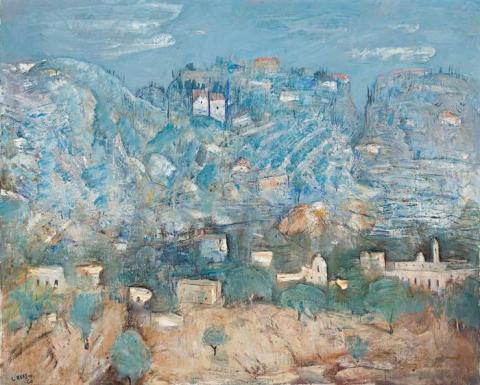THE ROAD OUTSIDE THE WALLS, SAN GIMIGNANO, 1960
Lloyd Rees
oil on canvas
67.0 x 82.0 cm
signed and dated lower left: L. REES / 60
inscribed verso: THE ROAD OUTSIDE THE WALLS / SAN GIMIGNANO 100 GNS
Macquarie Galleries, Sydney
Mr David McNicoll, Sydney
Christopher Day Gallery, Sydney
Acquired from the above c.1985
Private collection, Sydney
European Motifs by Lloyd Rees, Macquarie Galleries, Sydney, 10 – 20 May 1961, probably cat. 5 (as 'Tuscan Towers')
Free, R., Lloyd Rees, Lansdowne, Melbourne, 1972, cat. 0211
The medieval hill town of San Gimignano was one of Lloyd Rees' favourite places in Italy. He and his wife stayed there on a number of occasions', making numerous drawings, that resulted in many memorable works.1 Related drawings from his 1959 visit, to which this painting belongs, are variously titled 'Outside the Walls of San Gimignano' or 'San Gimignano - The Walls'. They are all in private collections. A later, marvellous pen and ink drawing, The Ramparts of San Gimignano, 1973, is in the University of Sydney. Each is redolent with that blend of architectural and natural beauty, which is so much a part of the appeal of Italy. 'The Tuscan town of San Gimignano is dearer to his heart, for there, as I know from experience, one is close to the earth', wrote his friend Douglas Dundas.2
From his first visit in 1923, Italy had 'an abiding influence' in Rees' life and art, as the numerous works of Rome, Arezzo, Naples, and especially the Tuscan countryside around San Gimignano bear rich testament.3 The particular appeal of San Gimignano lies in its surviving historical architecture history and the glory of the surrounding landscape. Among Italy's best-preserved medieval towns, it is still dominated by tall towers dating from the thirteenth century, symbols of the formidable fortresses of the wealthy in times of civil strife. Outside the walls the landscape spreads across tilled fields, olive groves and terraced vineyards, seemingly as old as the rich earth from which they grow. The Road Outside the Walls, San Gimignano was the result of Rees' third visit to Italy in 1959, completed in the studio after his return to Sydney. Renée Free, in her introductory essay to the 1969 Rees retrospective exhibition catalogue organised by the Art Gallery of New South Wales, noted that on this European visit Rees was concerned more 'with the monuments of other civilizations' than in the past, the paintings often being 'composite arrangements of symbolic motifs.'4 This is certainly so for The Road Outside the Walls, San Gimignano, in which the grandeur of the man-made is celebrated in harmony with that of nature. The same approach can be seen in The Stones of Athens, 1961, (Queensland University Art Museum), both paintings excelling in the combination of architectural splendour and landscape, and an inspirational blend of classical imagery and technique. The ancient façades and their subtle reliefs echo in the classical focus on the pictorial surface, enriched by an abundance of colour and that noble profile of the hilly land.
1. Rees, L., The Small Treasures of a Lifetime, Ure Smith, Sydney, 1969, p. 142
2. Dundas, D., 'Lloyd Rees', Art and Australia, vol.7, no.2, September 1969, p. 130
3. Rees, op. cit., p. 140
4. Free, R., 'The Landscape of Lloyd Rees', Lloyd Rees Retrospective, Art Gallery of New South Wales, Sydney, 1969, p. 11
DAVID THOMAS
